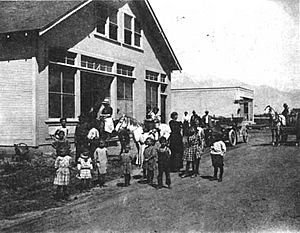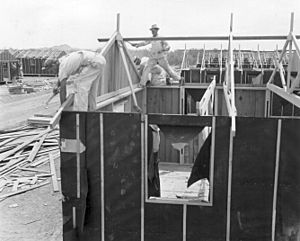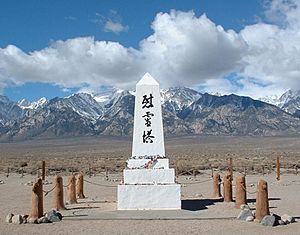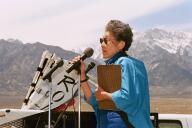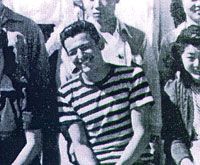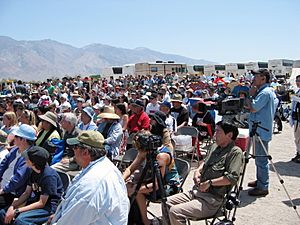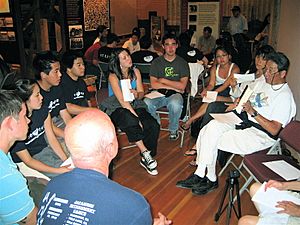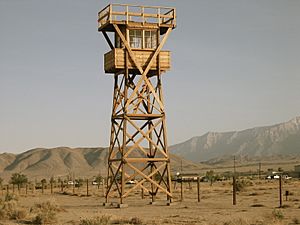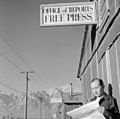Manzanar facts for kids
|
Manzanar War Relocation Center
|
|
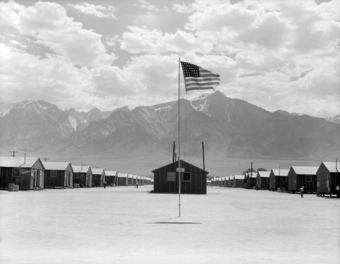
A hot windstorm brings dust from the surrounding desert, July 3, 1942
|
|
| Location | Inyo County, California |
|---|---|
| Nearest city | Independence, California |
| Area | 814 acres (329 ha) |
| Built | 1942 |
| Visitation | 97,382 (2019) |
| Website | Manzanar National Historic Site |
| NRHP reference No. | 76000484 |
Quick facts for kids Significant dates |
|
| Added to NRHP | July 30, 1976 |
| Designated NHL | February 4, 1985 |
| Designated NHS | March 3, 1992 |
Manzanar is the site of one of ten American concentration camps, where more than 120,000 Japanese Americans were incarcerated during World War II from March 1942 to November 1945. It is located at the foot of the Sierra Nevada mountains in California's Owens Valley, between the towns of Lone Pine to the south and Independence to the north, approximately 230 miles (370 km) north of Los Angeles. Manzanar means "apple orchard" in Spanish. The Manzanar National Historic Site, which preserves and interprets the legacy of Japanese American incarceration in the United States, was identified by the United States National Park Service as the best-preserved of the ten former camp sites.
Since the last of those incarcerated left in 1945, former detainees and others have worked to protect Manzanar and to establish it as a National Historic Site to ensure that the history of the site, along with the stories of those who were incarcerated there, is recorded for current and future generations. The primary focus is the Japanese American incarceration era, as specified in the legislation that created the Manzanar National Historic Site. The site also interprets the former town of Manzanar, the ranch days, the settlement by the Owens Valley Paiute, and the role that water played in shaping the history of the Owens Valley.
Contents
Terminology
Since the end of World War II, there has been debate over the terminology used to refer to Manzanar, and the other camps in which Americans of Japanese ancestry and their immigrant parents, were incarcerated by the United States Government during the war. Manzanar has been referred to as a "War Relocation Center," "relocation camp," "relocation center," "internment camp", and "concentration camp", and the controversy over which term is the most accurate and appropriate continues to the present day.
Before World War II
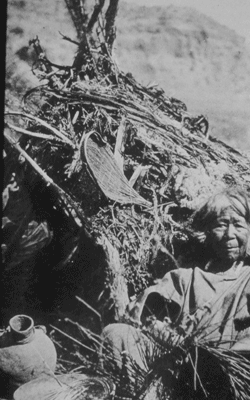
Owens Valley Paiute
Manzanar was first inhabited by Native Americans nearly 10,000 years ago. Approximately 1,500 years ago, the area was settled by the Owens Valley Paiute, who ranged across the Owens Valley from Long Valley on the north to Owens Lake on the south, and from the crest of the Sierra Nevada on the west to the Inyo Mountains on the east. Other Native American nations in the region included the Miwok, Western Mono, and Tubatulabal to the west, the Shoshone to the south and east, and the Mono Lake Paiute to the north. The Owens Valley Paiute hunted and fished, collected pine nuts, and raised crops utilizing irrigation in the Manzanar area. They also traded brown-ware pottery for salt from the Saline Valley, and traded other wares and goods across the Sierra Nevada during the summer and fall.
The Owens Valley had received scant attention from European Americans before the early 1860s, as it was little more than a crossroads of the routes through the area. When gold and silver were discovered in the Sierra Nevada and the Inyo Mountains, the resulting sudden influx of miners, farmers, cattlemen and their hungry herds brought conflict with the Owens Valley Paiute, whose crops were being destroyed. The Owens Valley Indian War of 1861–1863 ensued; at the end, the Owens Valley Paiute, along with other native peoples in the region, were forced at gunpoint by the United States Army to walk almost 200 miles (320 km) to Fort Tejon, in one of the many forced relocations or "Trails of Tears" inflicted upon Native Americans in the United States.
Approximately one-third of the Native Americans in the Owens Valley were forcibly relocated to Fort Tejon. After 1863, many returned to their permanent villages that had been established along creeks flowing down from the Sierra Nevada mountains. In the Manzanar area, the Owens Valley Paiute had established villages along Bairs, Georges, Shepherds, and Symmes creeks. Evidence of Paiute settlement in the area is still present.
Ranchers
When European American settlers first arrived in the Owens Valley in the mid–19th century, they found a number of large Paiute villages in the Manzanar area. John Shepherd, one of the first of the new settlers, homesteaded 160 acres (65 ha) of land 3 miles (5 km) north of Georges Creek in 1864. With the help of Owens Valley Paiute field workers and laborers, he expanded his ranch to 2,000 acres (810 ha).
In 1905, George Chaffey, an agricultural developer from Southern California, purchased Shepherd's ranch and subdivided it, along with other adjacent ranches. He founded the town of Manzanar in 1910. Chaffey's Owens Valley Improvement Company built an irrigation system and planted thousands of fruit trees. By 1920, the town had more than twenty-five homes, a two-room school, a town hall, and a general store. Also at that time, nearly 5,000 acres (2,000 ha) of apple, pear, and peach trees were under cultivation; along with crops of grapes, prunes, potatoes, corn and alfalfa; and large vegetable and flower gardens.
"Manzanar was a very happy place and a pleasant place to live during those years, with its peach, pear, and apple orchards, alfalfa fields, tree-lined country lanes, meadows and corn fields," said Martha Mills, who lived at Manzanar from 1916 to 1920.
Some of the early orchards, along with remnants of the town and ranches, are still present at Manzanar today.
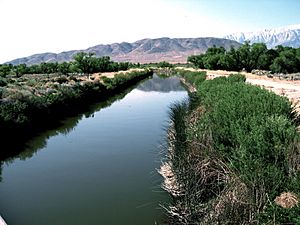
Quenching Los Angeles' thirst
As early as March 1905, the City of Los Angeles began secretly acquiring water rights in the Owens Valley. In 1913, it completed construction of its 233-mile (375 km) Los Angeles Aqueduct, But it did not take long for Los Angeles water officials to realize that Owens River water was not enough to supply the rapidly growing metropolis. In 1920, they began to purchase more of the water rights on the Owens Valley floor. As the decade went on, the City of Los Angeles bought out one Owens Valley farmer after another, and extended its reach northward into Mono County, including Long Valley. By 1933, the City owned 85% of all town property and 95% of all ranch and farm land in the Owens Valley, including Manzanar.
Although some residents sold their land for prices that made them financially independent and relocated, a significant number chose to stay. In dry years, Los Angeles pumped ground water and drained all surface water, diverting all of it into its aqueduct and leaving Owens Valley ranchers without water. Without water for irrigation, the holdout ranchers were forced off their ranches and out of their communities; that included the town of Manzanar, which was abandoned by 1929.
'There was so much water during those early years, that when a horse pulled a buggy, the water frequently came up to the horse's knees,' said Lucille DeBoer, who lived on a ranch at Manzanar. 'When this happened, the children took off their shoes and socks to walk home. In the early 1900s the City of Los Angeles started to purchase ranches in the Owens Valley for the sole purpose of supplying water to the people in Los Angeles. People started to sell their land to the City; the City put in wells to drain the water out of the ground; the trees began to die; and the land finally turned to vacant dirt. This ended the Land of the Big Red Apples.'
Manzanar remained uninhabited until the United States Army leased 6,200 acres (2,500 ha) from the City of Los Angeles for the Manzanar War Relocation Center.
Wartime: 1942–45
After the December 7, 1941, attack on Pearl Harbor, the United States Government swiftly moved to begin solving the "Japanese Problem" on the West Coast of the United States. In the evening hours of that same day, the Federal Bureau of Investigation (FBI) arrested selected "enemy" aliens, including 2,192 who were of Japanese descent. The California government pressed for action by the national government, as many citizens were alarmed about potential activities by people of Japanese descent.
On February 19, 1942, President Franklin D. Roosevelt signed Executive Order 9066, which authorized the Secretary of War to designate military commanders to prescribe military areas and to exclude "any or all persons" from such areas. The order also authorized the construction of what would later be called "relocation centers" by the War Relocation Authority (WRA) to house those who were to be excluded. This order resulted in the forced relocation of over 120,000 Japanese Americans, two-thirds of whom were native-born American citizens. The rest had been prevented from becoming citizens by federal law. Over 110,000 were incarcerated in the ten concentration camps located far inland and away from the coast.
Manzanar was the first of the ten concentration camps to be established. Initially, it was a temporary "reception center", known as the Owens Valley Reception Center from March 21, 1942, to May 31, 1942. At that time, it was operated by the US Army's Wartime Civilian Control Administration (WCCA).
The Owens Valley Reception Center was transferred to the WRA on June 1, 1942, and officially became the "Manzanar War Relocation Center." The first Japanese American incarcerees to arrive at Manzanar were volunteers who helped build the camp. By mid–April, up to 1,000 Japanese Americans were arriving daily, and by July, the population of the camp neared 10,000. Over 90 percent of the incarcerees were from the Los Angeles area, with the rest coming from Stockton, California; and Bainbridge Island, Washington. Many were farmers and fishermen. Manzanar held 10,046 incarcerees at its peak, and a total of 11,070 people were incarcerated there.
Climate
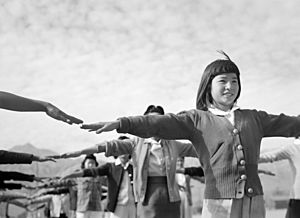
The weather at Manzanar caused suffering for the incarcerees, few of whom were accustomed to the extremes of the area's climate. The temporary buildings were not adequate to shield people from the weather. The Owens Valley lies at an elevation of about 4,000 feet (1,200 m). Summers on the desert floor of the Owens Valley are generally hot, with temperatures exceeding 100 °F (38 °C) not uncommon. Winters bring occasional snowfall and daytime temperatures that often drop into the 40 °F (4 °C) range. At night, temperatures are generally 30 to 40 °F (17 to 22 °C) lower than the daytime highs, and high winds are common day or night. The area's mean annual precipitation is barely five inches (12.7 cm). The ever-present dust was a continual problem due to the frequent high winds; so much so that incarcerees usually woke up in the morning covered from head to toe with a fine layer of dust, and they constantly had to sweep dirt out of the barracks.
"In the summer, the heat was unbearable," said former Manzanar incarceree Ralph Lazo (see Notable incarcerees section, below). "In the winter, the sparsely rationed oil didn't adequately heat the tar paper-covered pine barracks with knotholes in the floor. The wind would blow so hard, it would toss rocks around."
Camp layout and facilities
The camp site was situated on 6,200 acres (2,500 ha) at Manzanar, leased from the City of Los Angeles, with the developed portion covering approximately 540 acres (220 ha). The residential area was about one square mile (2.6 km2), and consisted of 36 blocks of hastily constructed, 20-foot (6.1 m) by 100-foot (30 m) tarpaper barracks, with each incarceree family living in a single 20-foot (6.1 m) by 25-foot (7.6 m) "apartment" in the barracks. These apartments consisted of partitions with no ceilings, eliminating any chance of privacy. Lack of privacy was a major problem for the incarcerees, especially since the camp had communal men's and women's latrines.
"...One of the hardest things to endure was the communal latrines, with no partitions; and showers with no stalls," said former Manzanar incarceree Rosie Kakuuchi.
Each residential block also had a communal mess hall, a laundry room, a recreation hall, an ironing room, and a heating oil storage tank, although Block 33 lacked a recreation hall. In addition to the residential blocks, Manzanar had 34 additional blocks that had staff housing, camp administration offices, two warehouses, a garage, a camp hospital, and 24 firebreaks. The camp also had school facilities, a high school auditorium, staff housing, chicken and hog farms, churches, a cemetery, a post office, a cooperative store, other shops, a camp newspaper, and other necessary amenities that one would expect to find in most American cities.
Manzanar also had a camouflage net factory, an experimental plantation for producing natural rubber from the Guayule plant, and an orphanage called Children's Village, which housed 101 Japanese American orphans. The camp perimeter had eight watchtowers manned by armed Military Police, and it was enclosed by five-strand barbed wire. There were sentry posts at the main entrance.
Life behind the barbed wire
After being uprooted from their homes and communities, the incarcerees found themselves having to endure primitive, sub-standard conditions, and lack of privacy. They had to wait in one line after another for meals, at latrines, and at the laundry room. Each camp was intended to be self-sufficient, and Manzanar was no exception. Cooperatives operated various services, such as the camp newspaper, beauty and barber shops, shoe repair, and more. In addition, incarcerees raised chickens, hogs, and vegetables, and cultivated the existing orchards for fruit. Incarcerees made their own soy sauce and tofu.
Food at Manzanar was based on military requirements. Meals usually consisted of hot rice and vegetables, since meat was scarce due to rationing. In early 1944, a chicken ranch began operation, and in late April of the same year, the camp opened a hog farm. Both operations provided welcome meat supplements to the incarcerees' diet.
Most incarcerees were employed at Manzanar to keep the camp running. Unskilled workers earned US$8 per month ($143.3 per month as of 2024), semi-skilled workers earned $12 per month ($215 per month as of 2024), skilled workers made $16 per month ($287 per month as of 2024), and professionals earned $19 per month ($340 per month as of 2024). In addition, all incarcerees received $3.60 per month ($64 per month as of 2024) as a clothing allowance.
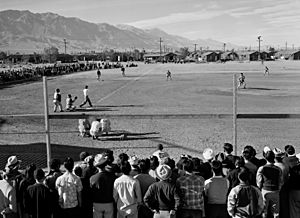
The incarcerees made Manzanar more livable through recreation. They participated in sports, including baseball and football, and martial arts. They also personalized and beautified their barren surroundings by building elaborate gardens, which often included pools, waterfalls, and rock ornaments. There was even a nine-hole golf course. Remnants of some of the gardens, pools, and rock ornaments are still present at Manzanar.
Resistance
Although most incarcerees quietly accepted their fate during World War II, there was some resistance in the camps. Poston, Heart Mountain, Topaz, and Tule Lake each had civil disturbances about wage differences, black marketing of sugar, intergenerational friction, rumors of "informers" reporting to the camp administration or the FBI, and other issues. However, the most serious incident occurred at Manzanar on December 5–6, 1942, and became known as the Manzanar Riot.
After several months of tension between incarcerees who supported the Japanese American Citizens League (JACL) and a group of Kibei (Japanese Americans educated in Japan), rumors spread that sugar and meat shortages were the result of black marketing by camp administrators. To make matters worse, incarceree and JACL leader Fred Tayama was beaten by six masked men. Harry Ueno, the leader of the Kitchen Workers Union, was suspected of involvement and was arrested and removed from Manzanar. Soon after, 3,000 to 4,000 incarcerees gathered and marched to the administration area, protesting Ueno's arrest. After Ueno's supporters negotiated with the camp administration, he was returned to the Manzanar jail. A crowd of several hundred returned to protest, and when the people surged forward, military police threw tear gas to disperse them. As people ran to avoid the tear gas, some in the crowd pushed a driverless truck toward the jail. At that moment, the military police fired into the crowds.
Closure
On November 21, 1945, the WRA closed Manzanar, the sixth camp to be closed. Although the incarcerees had been brought to the Owens Valley by the United States Government, they had to leave the camp and travel to their next destinations on their own. The WRA gave each person $25 ($406 today), one-way train or bus fare, and meals to those who had less than $600 ($9,753 today). While many left the camp voluntarily, a significant number refused to leave because they had no place to go after having lost everything when they were forcibly uprooted and removed from their homes. As such, they had to be forcibly removed once again, this time from Manzanar. Indeed, those who refused to leave were generally removed from their barracks, sometimes by force, even if they had no place to go.
146 incarcerees died at Manzanar. Fifteen incarcerees were buried there, but only five graves remain, as most were later reburied elsewhere by their families.
The Manzanar cemetery site is marked by a monument that was built by incarceree stonemason Ryozo Kado in 1943. An inscription in Japanese on the front (east side) of the monument reads 慰靈塔 ("Soul Consoling Tower"). The inscription on the back (west side) reads "Erected by the Manzanar Japanese" on the left-hand column, and "August 1943" on the right-hand column. Today, the monument is often draped in strings of origami, and sometimes survivors and other visitors leave offerings of personal items as mementos. The National Park Service periodically collects and catalogues such items.
After the camp was closed, the site eventually returned to its original state. Within a couple of years, all the structures had been removed, with the exception of the two sentry posts at the entrance, the cemetery monument, and the former Manzanar High School auditorium, which was purchased by the County of Inyo. The County leased the auditorium to the Independence Veterans of Foreign Wars, who used it as a meeting facility and community theater until 1951. After that, the building was used as a maintenance facility by the Inyo County Road Department.
As of 2007, the site also retains numerous building foundations, portions of the water and sewer systems, the outline of the road grid, remains of the landscaping constructed by incarcerees, and much more. Despite four years of use by the incarcerees, the site also retains evidence of the ranches and of the town of Manzanar, as well as artifacts from the days of the Owens Valley Paiute settlement.
Notable incarcerees
- Sue Kunitomi Embrey, born on January 6, 1923, was an editor of the Manzanar Free Press, the camp newspaper, and wove camouflage nets to support the war effort. She left Manzanar in late 1943 for Madison, Wisconsin and one year later moved to Chicago, Illinois. Returning to California in 1948, she went on to become a schoolteacher and a labor and community activist. In 1969, Embrey was one of approximately 150 people who attended the first organized Manzanar Pilgrimage (see Manzanar Pilgrimage section, below) and was one of the founders of the annual event. She also went on to become the primary force behind the preservation of the site and its gaining National Historic Site status until her death in May, 2006.
'Embrey took her pain and anger from the unjust internment and turned it into a life dedicated to making certain that would never happen again,' said Rose Ochi, legal counsel for the Manzanar Committee, after Embrey died on May 15, 2006. 'She was just tireless and as a teacher she was making certain that our history books did talk about the tragic episode.'
'The reason [that the Manzanar National Historic Site has] been accepted by Japanese Americans, local Owens Valley residents and general visitors is in large part because of [Embrey's] knowledge and her personal experience,' said Alisa Lynch, Chief of Interpretation, Manzanar National Historic Site. 'She had the insight to help us be able to be truthful, to be accurate. She was a historian and an internee, she could wear many different hats.'
- Aiko Herzig-Yoshinaga, born in 1925 in Los Angeles, was 17 years old when she was incarcerated at Manzanar. Later, she was incarcerated at Jerome and Rohwer, Arkansas. Yoshinaga-Herzig later moved to New York, where she became a community activist in the 1960s and was a member of Asian Americans for Action (AAA), the first Asian American political organization on the East Coast. It included Asian American activists Bill and Yuri Kochiyama. Although she was not trained to be an archival researcher, Yoshinaga-Herzig decided to find out what historical documents about her and her family might exist at the National Archives.
- Herzig-Yoshinaga and her husband, John "Jack" Herzig, pored over mountains of documents from the War Relocation Authority, a task that "was roughly equivalent to indexing all the information in a library, working from a card catalog that only gave a subject description by shelf, without giving individual book titles or authors." Their efforts resulted in the discovery of evidence that the US Government perjured itself before the United States Supreme Court in the 1944 cases Korematsu v. United States, Hirabayashi v. United States, and Yasui v. United States which challenged the constitutionality of the relocation and incarceration. The government had presented falsified evidence to the Court, destroyed evidence, and had withheld other vital information. This evidence provided the legal basis Japanese Americans needed to seek redress and reparations for their wartime imprisonment. The Herzigs' research was also valuable in their work with the National Coalition for Japanese American Redress (NCJAR), which filed a class-action lawsuit against the US Government on behalf of the incarcerees. The US Supreme Court ruled against the plaintiff.
- Henry Fukuhara, who was born in Fruitland, California, in 1913, was incarcerated with his family in April 1942. An artist and watercolorist, Fukuhara would later teach a series of annual artistic workshops at Manzanar beginning in 1998. His workshops, which usually had about 80 students a year, including Milford Zornes, used outdoor structures at Manzanar to teach water color painting.
- William Hohri (1927–2010), was incarcerated at Manzanar when he was 15 years old. His family entered Manzanar on April 3, 1942, and remained behind the barbed wire until August 25, 1945. Hohri became a civil rights and anti-war activist after World War II. In the late 1970s he became the chair of the National Coalition for Japanese American Redress (NCJAR), which brought a class action lawsuit against the US Government on March 16, 1983, asserting that it had unjustly incarcerated Japanese Americans during World War II. The lawsuit stated 22 causes of action, including fifteen alleged violations of constitutional rights, and sought $27 billion in damages. Despite the fact the US Supreme Court eventually ruled against the class action plaintiffs, the lawsuit helped bring the Japanese American case for redress and reparations to public awareness. It showed the Congress and the Executive Branch that the US Government would have far greater exposure in the still-pending lawsuit than by legislation under consideration in Congress for reparations. The proposed bill called for $20,000 reparations payments to each former incarceree or their immediate relatives, along with money for a civil liberties education fund (see Civil Liberties Act of 1988).
...(The class action lawsuit) remained active until after Congress had passed the redress legislation. While it remained alive, it played a significant part in publicizing the issues. The NCJAR lawsuit demanded $220,000 for each individual whose liberties had been denied. This was more than 20 times greater than the $20,000 per surviving incarcerated person that the redress bills proposed, allowing proponents to portray the legislative solution as a moderate alternative.
- Ralph Lazo, born in 1924 in Los Angeles, was of Mexican American and Irish American descent, but when at age 16 he learned that his Japanese American friends and neighbors were being forcibly removed and incarcerated at Manzanar, he was outraged. Lazo was so incensed that he joined friends on a train that took hundreds to Manzanar in May 1942. Manzanar officials never asked him about his ancestry.
"Internment was immoral," Lazo told the Los Angeles Times. "It was wrong, and I couldn't accept it." "These people hadn't done anything that I hadn't done except to go to Japanese language school."
In 1944, Lazo was elected president of his class at Manzanar High School. He remained at Manzanar until August of that year, when he was inducted into the US Army. He served as a Staff Sergeant in the South Pacific until 1946, helping liberate the Philippines. Lazo was awarded the Bronze Star for heroism in combat. After the war, he was a strong supporter of redress and reparations for Japanese Americans incarcerated during the war. The film, Stand Up for Justice: The Ralph Lazo Story, documents his life story, particularly his stand against the incarceration.
- Toyo Miyatake, who was born in Kagawa, Shikoku, Japan, in 1896, immigrated to the United States in 1909. He settled in the Little Tokyo section of Los Angeles, and was incarcerated at Manzanar along with his family. A photographer, Miyatake smuggled a lens and film holder into Manzanar and later had a craftsman construct a wooden box with a door that hid the lens. He took many now-famous photos of life and the conditions at Manzanar. His contraband camera was eventually discovered by the camp administration and confiscated. However, camp director Ralph Merritt later allowed Miyatake to photograph freely within the camp, even though he was not allowed to actually press the shutter button, requiring a guard or camp official to perform this simple task. Merritt finally saw no point to this technicality, and allowed Miyatake to take photos.
- Togo Tanaka (1916–2009), editor of the Rafu Shimpo newspaper, was sent to the Manzanar, where he used his journalism experience to document conditions in the camp. A supporter of cooperation with the authorities, he was labeled a collaborator and was transferred to Death Valley after being the target of riots before the first anniversary of Pearl Harbor.
- Harry Ueno, born in Hawaii in 1907, was a Kibei (native-born Japanese American educated in Japan) who was incarcerated at Manzanar with his wife and children. After volunteering for mess hall work, Ueno discovered that Manzanar camp staff were stealing rationed sugar and meat and selling them on the black market. Ueno exposed the thefts, and worked to organize incarcerees to deal with them. This led to his arrest, which resulted in Ueno becoming the focal point of the Manzanar Riot. Ueno was one of the incarcerees featured in Emiko Omori's Emmy Award-winning film Rabbit in the Moon.
- "Ueno made us aware there was opposition in the camps," said Omori. "He made us feel that people did fight back and made us realize that one person can make a difference."
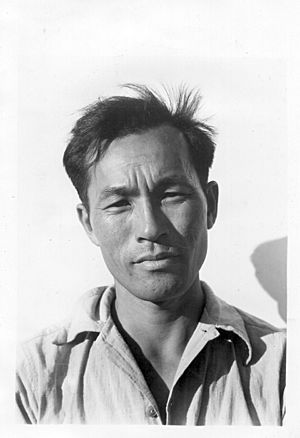
- Karl Yoneda was born in Glendale, California, on July 15, 1906, but his family moved back to Japan in 1913. He became an activist early in his life. With Japan on a path towards war, Yoneda returned to the United States rather than be drafted into the Japanese Army. He arrived in San Francisco on December 14, 1926. He was taken to the Immigration Detention House on Angel Island, where he was detained for two months, despite having his California birth certificate. Yoneda later moved to Los Angeles, where he found work organizing with the Trade Union Educational League, and later the Japanese Workers' Association. Yoneda arrived at Manzanar on March 22, 1942, one of the first Japanese Americans to arrive as a volunteer to build the camp. Yoneda later distinguished himself in service to the US, volunteering to serve in the Military Intelligence Service. After the war, Yoneda continued to support progressive causes and civil and human rights issues.
Other notable Manzanar incarcerees are: Koji Ariyoshi, Jeanne Wakatsuki Houston, Isao Kikuchi, Tura Satana, Gordon H. Sato, Tak Shindo, Larry Shinoda, Iwao Takamoto, Takuji Yamashita and Wendy Yoshimura.
Preservation and remembrance
Manzanar Pilgrimage
On December 21, 1969, about 150 people departed Los Angeles by car and bus, headed for Manzanar. It was the "first" annual Manzanar Pilgrimage. But as it turned out, two ministers, the Reverend Sentoku Mayeda and the Reverend Shoichi Wakahiro, had been making annual pilgrimages to Manzanar since the camp closed in 1945.
The non-profit Manzanar Committee, formerly led by Sue Kunitomi Embrey, has sponsored the Pilgrimage since 1969. The event is held annually on the last Saturday of April with hundreds of visitors of all ages and backgrounds, including some former incarcerees, gathering at the Manzanar cemetery to remember the incarceration. The hope is that participants can learn about it and help ensure that what is generally accepted to be a tragic chapter in American History is neither forgotten nor repeated. The program traditionally consists of speakers, cultural performances, an interfaith service to memorialize those who died at Manzanar, and Ondo dancing.
"My mother was a very staunch Buddhist and she would always say, 'Those poor people that are buried over there at Manzanar in the hot sun—they must be so dry. Be sure to take some water [as offerings],'" said Embrey. "She always thought it was important to go back and remember the people who had died."
In 1997, the Manzanar At Dusk program became a part of the Pilgrimage. The program attracts local area residents, as well as descendants of Manzanar's ranch days and the town of Manzanar. Through small group discussions, the event gives participants the opportunity to hear directly about the experiences of former incarcerees first-hand, to share their experiences and feelings about what they learned, and talk about the relevance of what happened at Manzanar to their own lives.
Since the September 11 attacks, American Muslims have participated in the Pilgrimage to promote and increase awareness of civil rights protections in the wake of widespread suspicions harbored against them post-9/11.
California Historical Landmark and Los Angeles Historic-Cultural Monument
The Manzanar Committee's efforts resulted in the State of California naming Manzanar as California Historical Landmark #850 in 1972, with an historical marker being placed at the sentry post on April 14, 1973.
Manzanar, which had been historically owned by the City of Los Angeles, was registered as a Los Angeles Historic-Cultural Monument in 1976.
National Historic Landmark and National Historic Site
The Manzanar Committee also spearheaded efforts for Manzanar to be listed in the National Register of Historic Places, and in February 1985, Manzanar was designated a National Historic Landmark. Embrey and the Committee also led the effort to have Manzanar designated a National Historic Site, and on March 3, 1992, President George H. W. Bush signed House Resolution 543 into law (Pub.L. 102-248; 106 Stat. 40). This act of Congress established the Manzanar National Historic Site "to provide for the protection and interpretation of the historical, cultural, and natural resources associated with the relocation of Japanese Americans during World War II." Five years later, the National Park Service acquired 814 acres (329 ha) of land at Manzanar from the City of Los Angeles.
The site features an Interpretive Center housed in the historically restored Manzanar High School Auditorium, which has a permanent exhibit that tells the stories of the incarcerees at Manzanar, the Owens Valley Paiute, the ranchers, the town of Manzanar, and water in the Owens Valley.
'...Stories like this need to be told, and too many of us have died without telling our stories,' Embrey said during her remarks at the Grand Opening ceremonies for the Manzanar National Historic Site Interpretive Center on April 24, 2004. 'The Interpretive Center is important because it needs to show to the world that America is strong as it makes amends for the wrongs it has committed, and that we will always remember Manzanar because of that.'
The site, which has seen 1,144,316 people visit from 2000 through August 2015, features restored sentry posts at the camp entrance, a replica of a camp guard tower built in 2005, a self-guided tour road, and informational markers. Staff offer guided tours and other educational programs, including a Junior Ranger educational program for children between four and fifteen years of age.
The National Park Service is reconstructing one of the 36 residential blocks as a demonstration block. One barrack appears as it would have when Japanese Americans first arrived at Manzanar in 1942, while another has been reconstructed to represent barracks life in 1945. Exhibits in these barracks opened on April 16, 2015. A restored World War II mess hall, moved to the site from Bishop Airport in 2002, was opened to visitors in late 2010.
In late 2008, historically appropriate vegetation was planted near the Interpretive Center. The Manzanar National Historic Site also unveiled its virtual museum on May 17, 2010 and continues to collect oral histories of former incarcerees and others from all periods of Manzanar's history.
Opposition to the creation of the Manzanar National Historic Site
After Congress named Manzanar a National Historic Site and gave the National Park Service the job of restoring the site in 1992, protests against its creation emerged. Letters flooded the National Park Service, demanding that Manzanar be portrayed as a guest housing center for the Japanese Americans. William Hastings, of Bishop, California, wrote to the National Park Service, saying that the portrayal of Manzanar as a concentration camp amounts to "treason." Protesters threatened to start dismissal campaigns against Bill Michael, a member of the Manzanar Advisory Commission who was the Director of the Eastern California Museum in Independence, California, and Superintendent Ross Hopkins, the National Park Service employee assigned to the site. They also threatened to destroy any buildings erected or restored at Manzanar. Further, Lillian Baker, and others in California, objected to the words, "concentration camp" on the California State historical marker, which has been hacked and stained, with the first "C" of "concentration camp" having been ground off. Further, a man, who described himself as a World War II veteran, called Hopkins to say that he had driven 200 miles to urinate on the marker.
In popular culture
A made-for-television movie, Farewell to Manzanar, directed by John Korty, aired on March 11, 1976, on NBC. It was based on the 1973 memoir of the same name, written by Jeanne Wakatsuki Houston, who was incarcerated at Manzanar as a child, and her husband James D. Houston. The book and the movie tell the story of the Wakatsuki family and their experiences behind the barbed wire through young Jeanne's eyes. On October 7, 2011, the Japanese American National Museum (JANM) announced that they had negotiated the rights to the movie, and that they would make it available for purchase on DVD.
Come See The Paradise was a feature film about how forced relocation and imprisonment at Manzanar affected a Japanese American family from Los Angeles and a European American union organizer. The film, released in 1990, starred Dennis Quaid and Tamlyn Tomita, and was written and directed by Alan Parker.
Folk/country musician Tom Russell wrote "Manzanar", a song about the Japanese American internment, that was released on his album Box of Visions (1993). Laurie Lewis covered the song on her album Seeing Things (1998), adding the Japanese string instrument, the koto, to her performance.
The 1994 award-winning novel, Snow Falling on Cedars by David Guterson, contains many scenes and details relating to Japanese Americans from the Puget Sound, Washington, area and their incarceration experiences at Manzanar. The 2000 film based on the book also details that connection.
The Asian American jazz fusion band Hiroshima has a song entitled "Manzanar" on its album The Bridge (2003). It is an instrumental song inspired by Manzanar and the Japanese American incarceration. Also, its song "Living In America", on its album titled East (1990), contains the phrase "I still remember Manzanar."
Fort Minor's song "Kenji", from the album The Rising Tied (2005), tells the true story of Mike Shinoda's family and their experiences before, during, and after World War II, including their imprisonment at Manzanar.
Channel 3's song titled "Manzanar" is about the incarceration.
In the 1984 movie The Karate Kid, Daniel reads the letter which informed Miyagi of the death of his wife and son during child birth on November 2, 1944 while in the Manzanar Relocation Camp. Mr. Miyagi is fighting for the US against the Germans in Europe when he received the news.
Images for kids
-
Two-year-old Yuki Okinaga Hayakawa waits at Union Station for the train taking her and her mother to Manzanar (April 1942)
See also
 In Spanish: Manzanar para niños
In Spanish: Manzanar para niños




